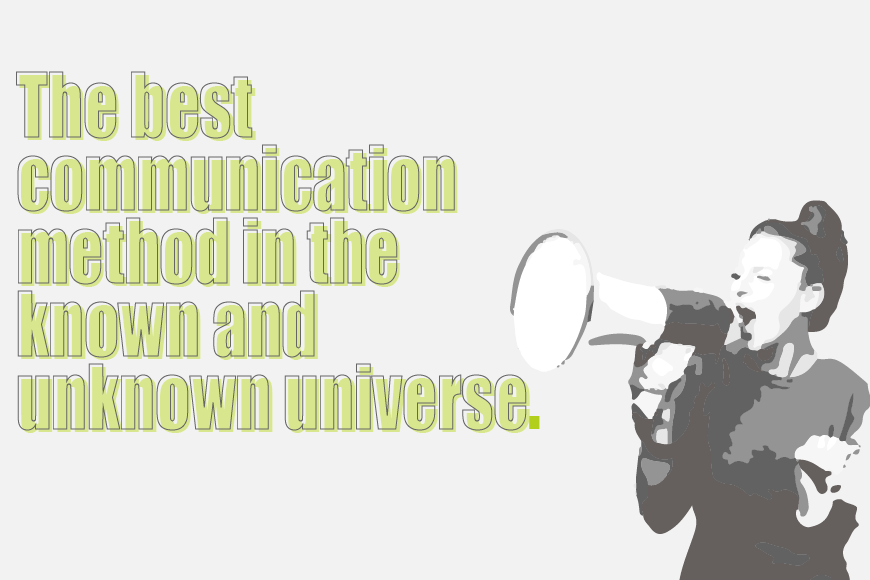The Best Communication Method in the Known and Unknown Universe
23 Feb 2018
Communication is the key to success for truly great companies. But there are lots of ways to communicate. How do you know which is best?
Our MD is tackling that very question in his latest article for the Norfolk Voice.
This article also appears in the latest issues of Business Intelligence, Business Direction, Business Comment and Business Edge.
There are a number of things that make up a great business: the people, ethos, core values and (of course) the product or service that you supply.
But if pressed to pick out the real key to great companies, I would have to say that it all comes down to communication. Knowing how to communicate with the different people you interact with is the foundation of great businesses.
Communication Methods
When you’re talking about effective communication, you need to know two things:
- Who are you talking to? and
- What’s the best approach?
I’ll start with the second one because it’s a little easier (shorter) to explain and it all comes back to two styles of writing: short hand and long hand.
Short hand, for anyone who isn’t familiar with the term, is a kind of code that lets you hand write (or even type) extremely quickly.
We use it at OpenCRM to refer to a way of speaking where we can remove some of the explanations and niceties and get straight down to the heart of the discussion – it will generally take less time and speed up decision and action. It does require everyone to be pretty switched onto the topic at hand, but definitely saves time and energy when you just need to get a message out the door.
Long hand, as you’ve probably guessed, just means writing out every letter of every word and includes every (correct) punctuation mark. We use it to refer to conversations that need more time, better explanations and generally involves a more protracted process to arrive at a decision.
These conversations take longer and are more detailed because that’s what’s required.
For example, when talking about a new feature, we’ll start with the long hand explanation: what does it need to do? What are the implications of it? How will people interact with it? Once the development is underway, we may move to more short handed discussions: “That bit needs to work better with the transition, it’s feeling a little lost right now.”
See what I mean? The short hand is only really understandable to people who know what it is about. But it sure saves time.
But what about the first question?
Choosing the right tone is super important when communicating your message, both in terms of ‘sending & receiving’. And that tone goes way beyond just what you’re talking about, it is vital to know who you’re talking to.
For effective communication you need to understand the groups of people that you will be collaborating with.
I tend to think about them in slightly sci-fi terms (don’t ask me why), so you’ve got your Crew, your Known Universe, and your Far Out Group.
Your Crew
These are generally your work colleagues, they are the people that you know well and the tone of the conversation can be mostly short hand. You like and trust each other and have a common set of values and goals.
You might need to use long hand for some conversations, but short hand works well here in a majority of cases.
Known Universe
These are people who you collaborate with often but who are not as well known. They are most likely clients, supplier, and prospects who are well into your sales cycle.
When communicating with people in your known universe, you will most certainly need a lot of long hand, but will probably develop your own version of short hand as you go along.
Your tone is different, not in terms of being professional, just has a more detailed approach to the process you are both following.
A question of tone: Crew vs Universe
Imagine you are with friends at a social event and want to pass on some news: you get the picture, its far more casual and you will generally have a feel for the room and how they will receive your message.
Imagine the same situation at a professional networking event: again, you will see the point, you will be more guarded around your communication style and perhaps less confident on how the message will be received by some members of the group.
The Far Out Group
Then there are those that you don’t communicate with very often or are completely unknown to you. They may be people who are reading your website (or magazine article) for the first time or who you meet at a conference or event.
These are the group where you will be far more cautious around your communication style, perhaps defaulting to a more traditional professional approach. You’ll need to rely on long hand with these people because you haven’t built up a relationship or a short hand with them yet.
But you will.
My point is there are different groups of people and different communication styles. Being able to recognise when you should change your style is crucial to great communication and great companies.